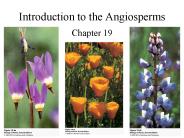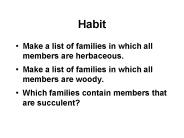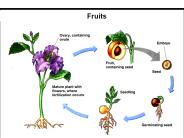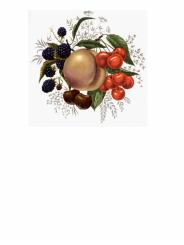Hypanthium PowerPoint PPT Presentations
All Time
Recommended
Hypanthium. stipules. Ranunculaceae 3,5- , ,3- No hypanthium. no stipules ... no hypanthium. From http://www.wisc.edu/ botit/img/bot/130/Angiosperm ...
| PowerPoint PPT presentation | free to view
2. Bisexual, 4-merous, inferior with a hypanthium present. ... 4. Placentation axile. Oenothera 'evening primroses', Gaura 'Gaura' Epilobium 'fireweeds' ...
| PowerPoint PPT presentation | free to view
Subclass: Rosidae Order: Myrtales Family: Onagraceae 1. Herbaceous. Subclass: Rosidae Order: Myrtales Family: Onagraceae 1. Herbaceous. 2. Bisexual, 4-merous ...
| PowerPoint PPT presentation | free to view
MORFOLOGI BUNGA 3 Rumus Bunga Rumus ... (e.g., G1 = monocarpous) Kelopak 5 Sepal lepas Mahkota 5 petal lepas Stamen 10 sampai banyak Putik 1 karpel superus FLORAL ...
| PowerPoint PPT presentation | free to download
One Word Who am I? Photos (describe the family also) More Photos Lots of Photos 5 pt 5 pt 5 pt 5 pt 5 pt 10 pt 10 pt 10 pt 10 pt 10 pt 15 pt 15 pt 15 pt 15 pt 15 pt
| PowerPoint PPT presentation | free to download
MORFOLOGI BUNGA 2 Bagian Bagian Bunga Pedicellus Receptaculum Periantium / Perigonium Androecium Stamen Gynaecium Pistillum Bagian-Bagian Bunga epicalyx The Main Part ...
| PowerPoint PPT presentation | free to download
Rosaceae -- the rose family (100/3000; Cosmopolitan, most common in temperate \subtropical N. Hemisphere) Rosidae Habit trees and shrubs, rarely herbs, usually armed
| PowerPoint PPT presentation | free to download
Early flowering Euphorbiaceae Violaceae Salicaceae Fabaceae Third largest family with 18,000 High nitrogen metabolism, often symbiotic with bacteria Lvs alt, ...
| PowerPoint PPT presentation | free to download
9. Almost Rosids to Rosids Santalales Lots of parasitism Polyacetylenes 1-seeded ovules, pendulous and free-central placentation Molecules In ours, flowers not ...
| PowerPoint PPT presentation | free to download
Diversity And Classification of Flowering Plants: Eudicots Michael G' Simpson
| PowerPoint PPT presentation | free to view
Orchidaceae -- the orchid family (835/20,000-30,000; mostly tropics but also in temperate latitudes) Monocots I Habit herbs, terrestrial, often epiphytic ...
| PowerPoint PPT presentation | free to download
Title: Systematic Implications of DNA variation in subfamily Opuntioideae Author: Unknown User Last modified by: Clark, Lynn G [EEOBS] Created Date
| PowerPoint PPT presentation | free to view
Plants and People Flowers Why a Flower? The Reproductive Structure of Flowering Plants: Flower Anatomy Flower Anatomy Flower Anatomy Flower Anatomy Flower Anatomy ...
| PowerPoint PPT presentation | free to view
Lauraceae. Trees, shrubs. Deciduous or evergreen. Often aromatic. ... Terminal bud conspicuous and enclosed by prominent bud scales or not (perulate) ...
| PowerPoint PPT presentation | free to view
Introduction to the Angiosperms Chapter 19 Angiosperms- Anthophyta Autotrophic, but parasitic and saprophytic representatives. Enclosure of ovules within carpels.
| PowerPoint PPT presentation | free to download
Caryophyllaceae-- the pink or carnation family (66-75/2,000; cosmopolitan with most in temperate and warm-temperate of Northern Hemisphere) Caryophyllidae
| PowerPoint PPT presentation | free to download
http://www.youtube.com/watch?v=trWzDlRvv1M But first, a review Nepenthes, a pitcher plant in the Caryophillid group Rosids I Crassulaceae Grossulariaceae Onagraceae ...
| PowerPoint PPT presentation | free to view
Diversity And Classification of Flowering Plants: Eudicots: Rosids Michael G' Simpson
| PowerPoint PPT presentation | free to view
... often reduced to scales or fleshy; sheathing at the base. Class: Liliopsida Order: Rosales Family: Orchidaceae Orchid Family One of the largest families.
| PowerPoint PPT presentation | free to view
ANGIOSPERM FAMILY
| PowerPoint PPT presentation | free to download
Flowers come in many different styles and forms. As a result of pollination and ... Sepals (collectively the calyx) Petals (collectively the corolla) ...
| PowerPoint PPT presentation | free to view
Primitive flower - blending of flower parts; spirally arranged. fossils, embryology, modern plants Degeneria. Carpel - primitive pistil. Carpel Formation ...
| PowerPoint PPT presentation | free to view
Aceraceae -- the maple family (2/120; Mostly New and Old World temperates, plus tropics of s.e. Asia) Rosidae II Habit shrubs or trees Leaves palmately-veined, simple ...
| PowerPoint PPT presentation | free to download
BIOLOGY 328 LAB Plants and People Objective To understand what a fruit is To study different parts of fruit To learn different types of fruits Background ...
| PowerPoint PPT presentation | free to view
Habit Make a list of families in which all members are herbaceous. Make a list of families in which all members are woody. Which families contain members that are ...
| PowerPoint PPT presentation | free to download
Fruits Multiple Fruit Multiple Fruit A fruit develops from the ovary wall after fertilization of the egg in the ovule 0 A seed ...
| PowerPoint PPT presentation | free to download
... turned upside down (resupinate) as it develops so the labellum is on the bottom ... connate, with the third petal (lip or labellum) usually elaborated in some way ...
| PowerPoint PPT presentation | free to view
those with hypogynous flowers usually bear a characteristic fleshy nectar ring ... Order Rosales. Family Crassulaceae. consists of about 35 genera and 1500 ...
| PowerPoint PPT presentation | free to view
Campanulids:Asterales: Campanulaceae(The Bellflower or Lobelia Family) Widespread in northern temperate and sub-tropical regions; also in the montane tropics
| PowerPoint PPT presentation | free to view
But now the theory goes That the apple's a rose, And the pear is, and so's The plum, I suppose. The dear only knows What will next prove a rose.
| PowerPoint PPT presentation | free to view
Title: PowerPoint Presentation Author: Preferred Customer Last modified by: Frank White Created Date: 2/4/2003 3:11:17 AM Document presentation format
| PowerPoint PPT presentation | free to view
Onagraceae Evening Primrose Family
| PowerPoint PPT presentation | free to view
Welcome to our tour
| PowerPoint PPT presentation | free to view
The Fruit The fruit is the mature gynoecium along with accessory tissues. As the fertilised egg develops, the gynoecium becomes the sole or main component of the flower.
| PowerPoint PPT presentation | free to download
Modern Protist Diversity Plant Clades Plant Clades From Algae to Plants Chara The Challenges of Land Evolution of First Plant Plant Innovations Timing of Innovations ...
| PowerPoint PPT presentation | free to view
Field Characteristics of Common Plant Families in New Mexico
| PowerPoint PPT presentation | free to view
'Geranium; flowers 5-merous, stamens with filaments united at base; fruit with ... GUIDE TO FLOWERING PLANT RECOGNITION (Phylogenetic System of Classification) ...
| PowerPoint PPT presentation | free to view
Inflorescences cymes (can appear ... Fruit aggregate of achenes [Floral formula: Ca 3 Co 3 A 6- G 6 ... Fruit achene or drupe [Floral formula: T 4 A 4 G 4 ] ...
| PowerPoint PPT presentation | free to view
Salicaceae Willow Family
| PowerPoint PPT presentation | free to view
Apples are part of the Rose Family (Rosaceae), a family that also contains ... Malus sieversii, or Malus pumila, forests still produce a variety of different fruits. ...
| PowerPoint PPT presentation | free to view
Also used as street and other landscaping trees/shrubs. ... in all members of this family, is a very unique characteristic of this family. ...
| PowerPoint PPT presentation | free to view
The Flower and Sexual Reproduction Chapter 13 Significance of the Flower Flowers and fruit least affected by environment Appearance of flowers and fruits important to ...
| PowerPoint PPT presentation | free to download
Loranthaceae/Viscaceae -- the mistletoe family(ies) (67-85/1000; cosmopolitan, ... Leaves opposite and decussate, simple, entire, parallel-veined, leathery to ...
| PowerPoint PPT presentation | free to view
SCB Tecate Cypress Poster
| PowerPoint PPT presentation | free to download
Inflorescences solitary or cymose (appearing raceme-like or head-like) ... Inflorescence corymb or raceme ... indeterminate as heads, racemes, or spikes ...
| PowerPoint PPT presentation | free to view













































